
Once the day began with a cup of coffee and a morning newspaper. These days, the love of coffee in the morning has not lost its relevance, but paper news outlets have been supplanted by smartphones, tablets and other gadgets connected to the Internet. And there is nothing wrong with that, because the World Wide Web allows us to receive information and communicate with people from different parts of the world. The amount of data generated in the world is constantly increasing every day. Every article, photo and even a two-word tweet is all part of the vast and ever-growing information field of the Earth. But these data are not ethereal, they do not float in the clouds, but are stored somewhere. Both our gadgets and specialized institutions - data centers serve as the place of data storage. Buildings filled to capacity with servers are expected to consume a lot of energy. Logicallythat as the global volume of data increases, so will the amount of energy consumed. Today we take a look at a study in which scientists from the University of Mainz (Germany) have developed a new technique for writing data to servers, which, in theory, can reduce power consumption in half. What physical and chemical processes are involved in the development, what have the experiments shown, and is the potential of this work as great as its authors say? We learn about this from the report of scientists. Go.What physical and chemical processes are involved in the development, what have the experiments shown, and is the potential of this work as great as its authors say? We learn about this from the report of scientists. Go.What physical and chemical processes are involved in the development, what have the experiments shown, and is the potential of this work as great as its authors say? We learn about this from the report of scientists. Go.
Basis of research
The root of all research is spintronics, the science that studies spin current transport. Spin, in turn, is the proper angular momentum of an elementary particle. In recent years, interest in spintronics has greatly increased, which has made it possible to discover a lot of new things, including switching current using spin-orbit moments (SOT from spin-orbit torque ) in magnetoresistive random access memory (MRAM).
Spin gates are one of the most important components of MRAM. These devices are composed of two or more conductive magnetic materials, the electrical resistance of which can vary between two values depending on the relative alignment of the magnetization in the layers.
SOT-induced switching occurs in ferromagnet-heavy metal (FM-HM) bilayers, where there is significant damping (suppression of oscillations) due to the flow of electric current along the x direction . SOTs arise from the spin Hall effect in the bulk of the HM material and from the reverse spin galvanic effect at the FM-HM interface.
Previous studies have shown that the value of the damped SOT can be large enough to switch the direction of magnetization at low current densities (up to 10 7 –10 8 A / cm -2 ).
Sample parameters (eg composition and thickness of the FM-HM heterostructure layer) can be adjusted to determine the magnitude and sign of the SOT. But, as scientists say, it is much more important to gain dynamic control in real time over the SOTs themselves.
One of the energy efficient tools for obtaining this control is mechanical stress caused by an electric field. The scientists recall that by avoiding the need for electric current and thus eliminating the associated losses, deformation effectively tunes the magnetic properties (such as magnetic anisotropy) and therefore the magnetic domain structure and dynamics of thin films in the plane. Moreover, since deformation can be applied locally, it provides a platform for the development and implementation of complex switching concepts in devices with a simplified architecture.
Attempts have already been made to investigate the effect of deformation on switching due to SOT, primarily the effect of deformation on anisotropy and the resulting effect on switching. In addition, previous research has focused exclusively on systems with a planar magnetic axis, and no experimental research has been carried out in perpendicularly magnetized multilayer materials.
However, according to the authors of this work, it is in perpendicularly magnetized multilayer materials that great potential lies. In particular, the promise of using systems with perpendicular magnetic anisotropy (PMA for perpendicular magnetic anisotropy ) is due to increased thermal stability, higher packing densities, and improved scaling.
In the study we are considering today, scientists have demonstrated electrically induced voltage control (mechanical) SOT in perpendicularly magnetized W = CoFeB = MgO multilayers grown on a piezoelectric substrate. SOTs are estimated by the secondary quantization method and by the magnetic transport method at plane voltages of different nature and magnitude.
Research results
It was found that deformation, modulated by an electric field applied to a piezoelectric substrate, results in distinct spin responses.
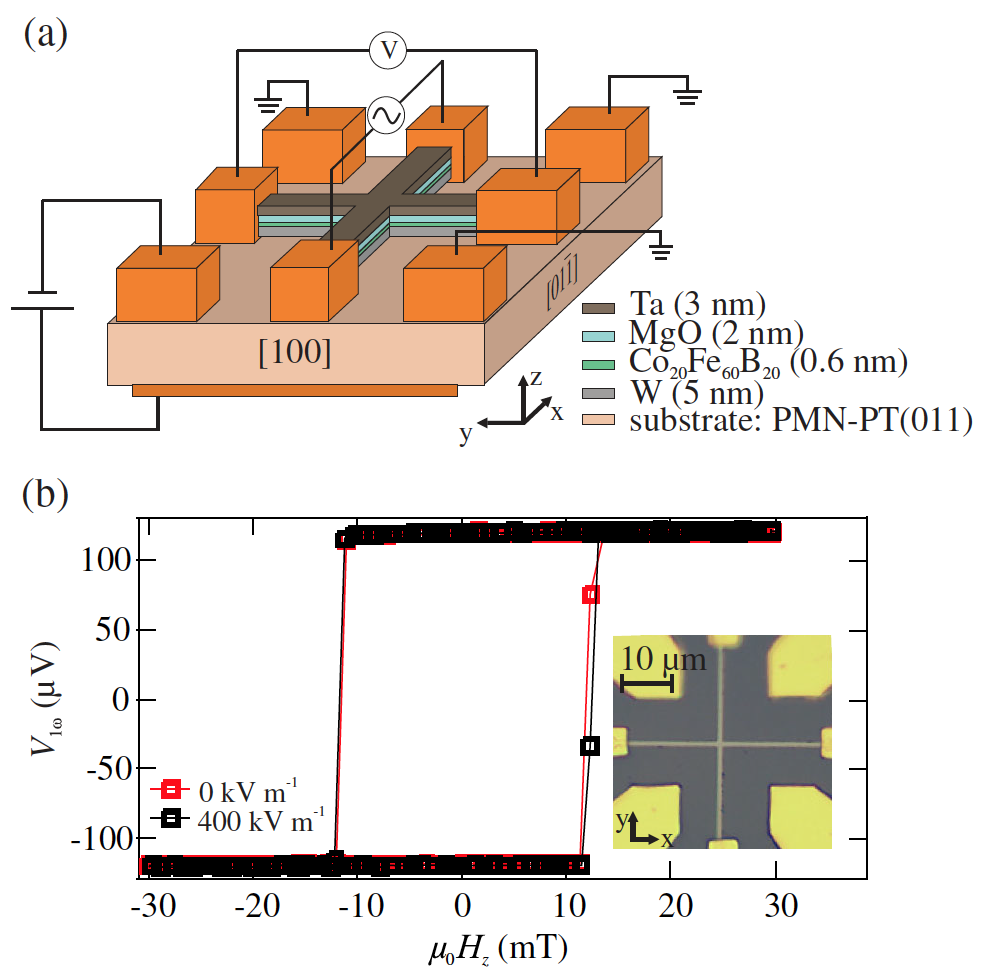
Image # 1
Image 1a shows a schematic of a cross-type Hall sensor * used to measure damping (DL) and field (FL) SOT fields in a W (5 nm) / CoFeB (0.6 nm) / MgO (2 nm) / Ta ( 3 nm). The multilayer was grown on a [Pb (Mg 0.33 Nb 0.66 O 3 )] 0.68 (011) substrate (abbreviated as PMN-PT), which was used for electrical generation of mechanical stresses. On 1b shows the device picture taken by an optical microscope.
* — .Uniaxial in-plane deformation was obtained by applying an out-of-plane DC electric field to a piezoelectric PMN-PT (011) substrate.
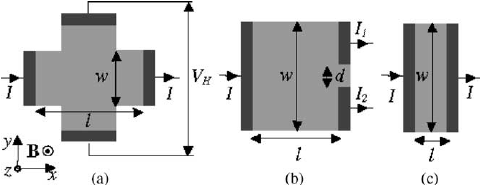
: — ; b — ; — .
Typically, the response of piezoelectric deformation to an applied electric field is hysteresis. However, electric fields that exceed the coercive * field characteristic of the material pole the substrate and result in a mode in which the generated strain has a linear response.
Coercive force * - the value of the magnetic field strength required to completely demagnetize the substance.The linear mode is maintained until the substrate is shifted in the other direction by the application of electric fields greater than the opposite coercive field. Therefore, before the first measurements, but after the structuring process, a polarization was applied to the PMN-PT substrate by means of an electric field of +400 kV / m.
Further, it was the direct current electric fields that were used, which made it possible to change the deformation in the linear response mode, since this provides reliable electrical control over the induced deformation.
It is also worth noting that the Hall intersection was made so that its shoulders were oriented along the [011] and [100] directions of the PMN-PT (011) substrate, which correspond to the stretching and compression directions, respectively.
To begin with, we characterize the magnetic hysteresis of the system at zero DC electric field.
Image 1b shows the anomalous Hall voltage line with an out-of-plane magnetic field (μ0 Hz) measured for W = CoFeB = MgO = Ta at 0 kV / m (red line), showing the easy axis (easy axis) switching characteristic of sets of thin CoFeB multilayers.
The out-of-plane magnetization cycle, measured at 400 kV / m (black line), is superimposed on top of the Hall voltage (red line) and shows no significant change due to the generated strain. This suggests that the system always has a dominant perpendicular magnetic anisotropy.
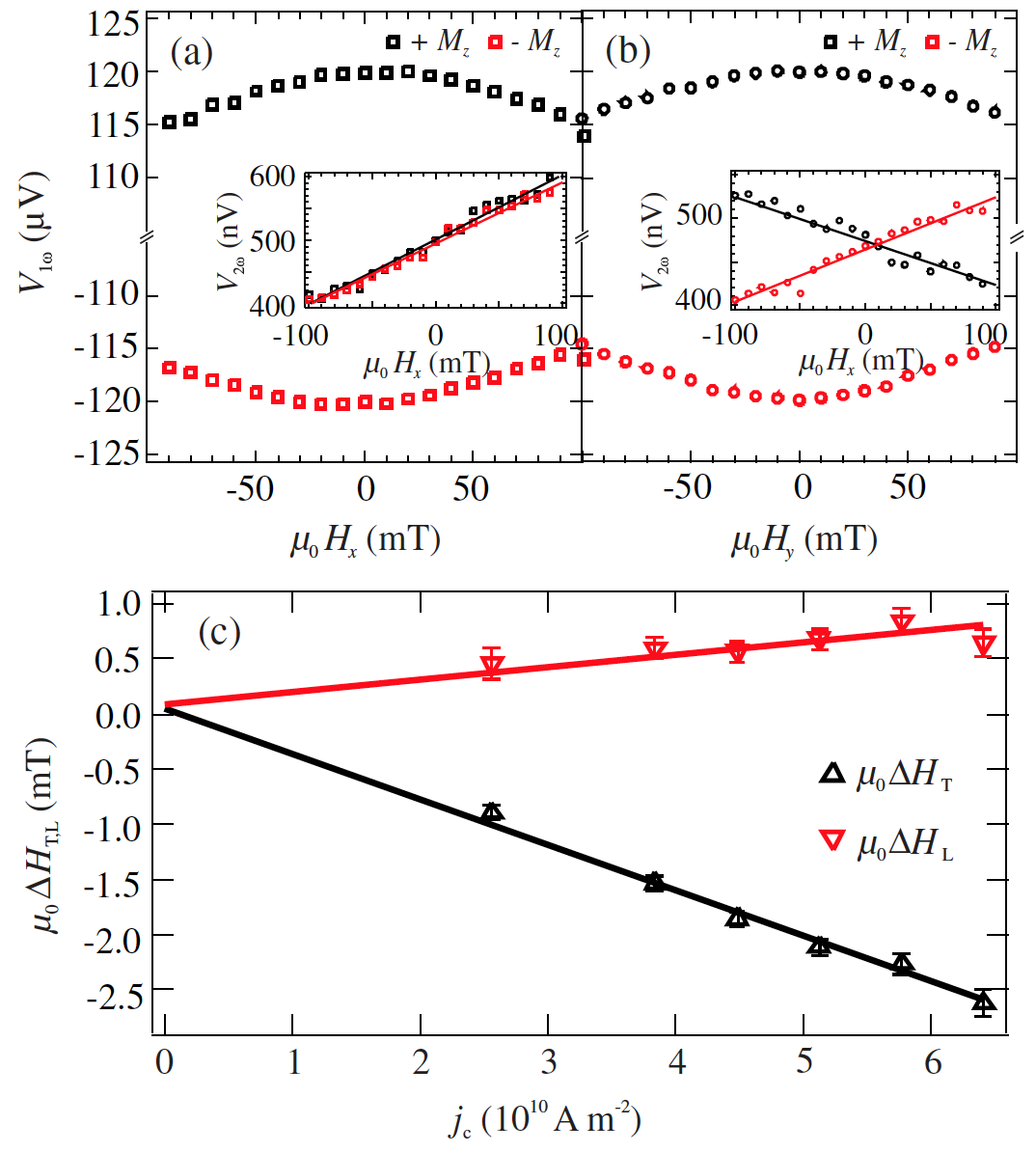
Image No. 2
The graphs above show typical in-plane dependences of the fields of the first (V 1ω ) and second (V 2ω ) Hall voltage harmonics when an alternating current with a density j c = 3.8 x 10 10 A / m -2 was applied to the current line .
The DC voltage was set to 0, so no voltage was applied to the Hall cross. The plots of the longitudinal ( 2a ) and transverse ( 2b ) fields show the expected symmetries: for the longitudinal field, the slopes V 2ω and the slopes of the field are the same for both directions of magnetization along + z (+ M z ) or -z (-M z), while for the transverse field their sign becomes opposite.
Next, scientists analyzed the transverse (μ 0 ΔH T ) and longitudinal (μ 0 ΔH L ) components of the SOT field for both directions of magnetization M z and determined the average value of these components as a function of the applied current density j c ( 2c ).
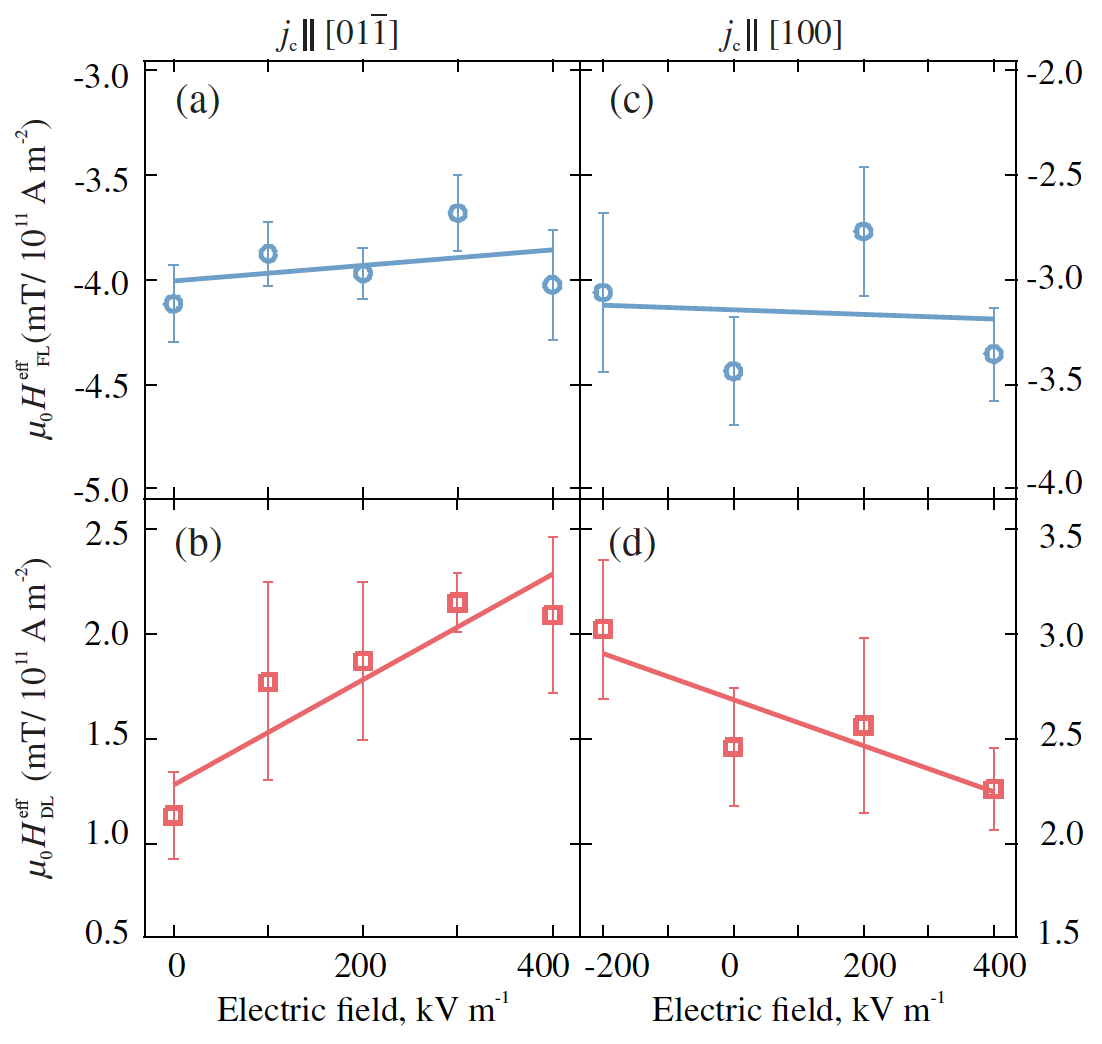
Image # 3 The
graphs above show the results of the dependence on the electric field. It was determined that the field (FL) SOT does not change significantly under tensile and compressive deformations ( 3a and 3c ). On the contrary, at 3bit can be seen that tensile deformation doubles the damping (DL) SOT when 400 kV / m (0.03% voltage) is applied.
On the other hand, when the current flows along the direction of the compression deformation, the DL value of the moment decreases with increasing deformation.
From this it follows that the magnitude DL of the moment increases with the application of an electrically induced tensile deformation and decreases with a compressive deformation.
To understand the microscopic origin of the experimentally observed deformation dependence of FL and DL SOT, functional calculations were performed using the density functional theory of the electronic structure Fe 1 - x Co x / W (001), consisting of a perpendicularly magnetized monolayer and nonmagnetic substrates.
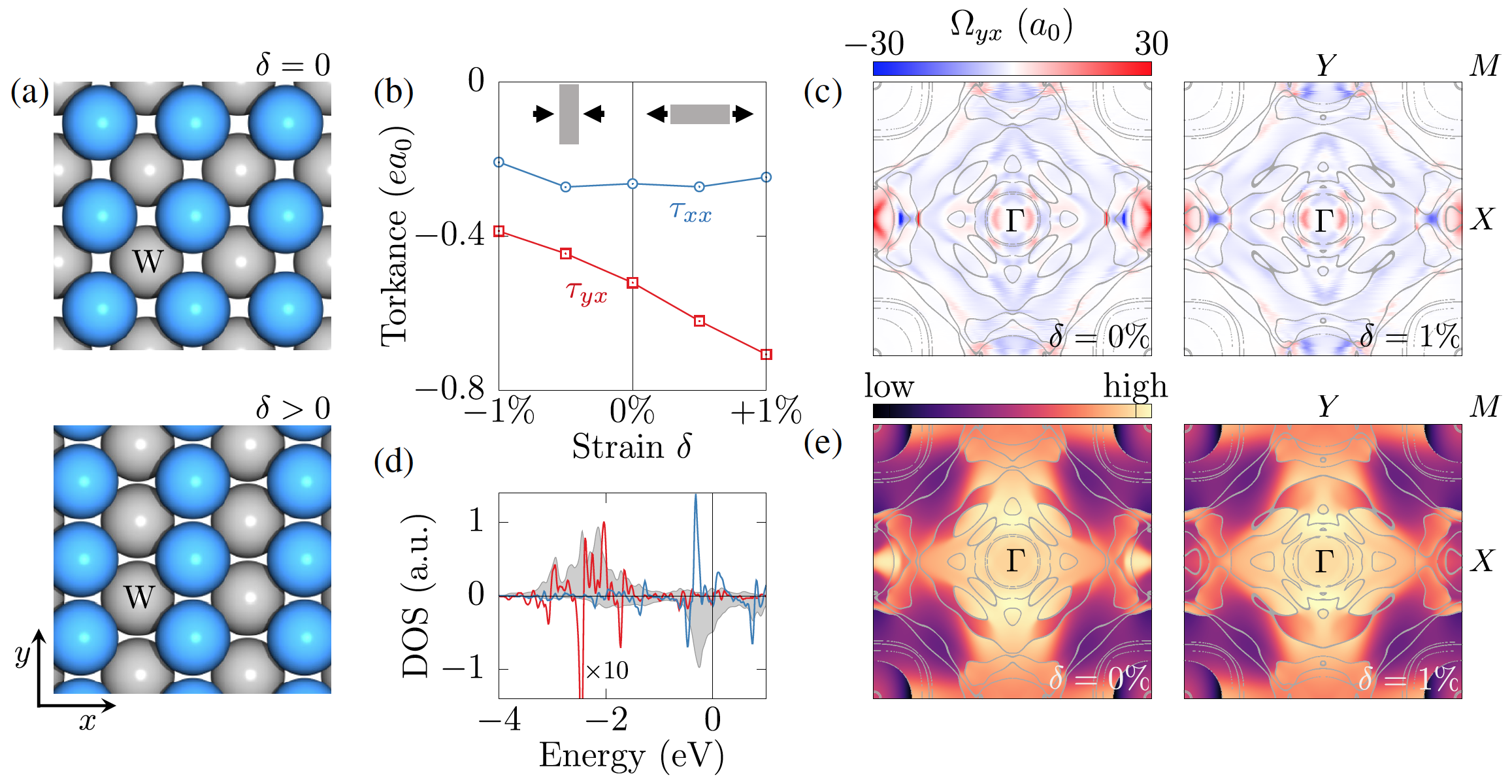
Image No. 4
As shown in 4a , during the calculations, the crystal structure deliberately expanded or contracted while maintaining a constant area in the plane of the unit cell to take into account the effect of uniaxial deformation. This deformation can be quantified by the ratio δ = (a ' j - a j ) / a j , where a j and a' j denote the lattice constant along the j-direction in the plane in a relaxed and distorted state, respectively. As a consequence, any final deformation reduces the initial crystal symmetry from C 4v to C 2v .
Based on the calculations of the electronic structure, the dependence of SOT on δ ( 4b), which exhibits the same quality characteristics as in the actual experiment.
Since FL and DL SOT come from different electronic states, they usually follow different dependences on structural features. It was found that the value DL of the moment increases linearly with respect to tensile deformation and linearly decreases with respect to compressive deformation. For example, expansion of the lattice by 1% along the direction of the electric field significantly increases the conductivity of DL moments (by about 35%).
To more accurately assess this observation, a comparison was made ( 4c) distributions in space of microscopic contributions to DL SOT for relaxed and deformed films. In contrast to the occupied states around the M point, which are hardly important, the electronic states near the high symmetry points Γ, X and Y constitute the main source of DL conductivity. In particular, tensile deformation promotes strong negative contributions around X and Y, resulting in an overall increase in conductivity.
To connect the obtained data with the available electronic structure, scientists drew attention to the orbital polarization of states in the magnetic layer, where d electrons are the dominant force.
While d xy , d x 2 - y 2 and d z 2do not depend on the sign of the applied deformation δ, the states d yz and d zx clearly change with respect to tensile or compressive deformation. Notably, these orbitals also mediate hybridization with the heavy metal substrate. It follows from this that their dependence on structural features provides an additional understanding of SOT in the thin films under study.
As an example, scientists propose to consider the deformation change in the density of states d yz in the magnetic layer in comparison with the case with fourfold rotational symmetry ( 4d ).
While the density of states ↓ * at the Fermi level is practically independent of tensile deformation, the states ↑ are clearly redistributed. As the orbital polarization at 4e shows , this effect is due to pronounced δ-controlled changes in polarization d yz around point X, which correlates with changes in the conductivity DL ( 4 ).
Spin channel * - one of the direction of the spin orientation (up or down).Using data obtained from calculations of the electronic structure, the scientists found that the different nature of the experimentally observed features of the FL and DL moments stems from unique changes in the orbital polarization of electronic states due to lattice distortions.
The subscript s = ↑, ↓ denotes the spin state of electrons in ferromagnets: ↑ is the spin subband of the majority of electrons, ↓ is the spin subband of the minority of electrons. In addition, the subscript s = ↑, ↓ denotes the spin state of the electron in the spin conduction channels.
For a more detailed acquaintance with the nuances of the study, I recommend that you look into the report of scientists .
Epilogue
According to the authors of the work, in addition to revealing the key role of hybridized states at the FM-HM interface, the study results offer a clear scheme for man-made spin-orbit phenomena. Using the complex interactions of spin and orbital magnetism, spin-orbit coupling and symmetry, one can adapt the SOT value in multilayer devices, creating orbital polarization of states near the Fermi energy with respect to strain.
It is also worth noting that this study expands the possibilities of engineering in the field of designing devices with dynamic SOT tuning in perpendicularly magnetized multilayer systems using electrically controlled voltage (mechanical).
This loud statement is due to the fact that deformation can be generated locally and superimposed on selected parts of the switching region. Therefore, it is possible to adjust the current density so that the DL spin can simultaneously control the direction of magnetization in areas with voltage, but not affect areas without voltage. The selected areas can then be modified on demand by using a different electrical field configuration, providing an additional level of control.
All this means that with the help of specific deformation patterns of the switching regions by means of electric fields, an energy-efficient multi-level memory cell can be created.
The application of deformation to the investigated structure W = CoFeB = MgO during the experiments led to distinctly different changes in the FL and DL spins. Moreover, as scientists note, DL spin can be doubled if tensile deformation is applied parallel to the current flow.
In other words, it is possible to gain direct control over the characteristics of the magnetic switching process by adjusting the electric field that acts on the piezoelectric crystal. This leads to a significant reduction in energy consumption, and also makes it possible to create complex architectures for storing information.
In the future, scientists plan to continue both practical experiments and related calculations in order to find out where and how it is possible to improve this complex process. However, despite the complexity of creating such systems, their potential is extremely high, because reducing energy consumption leads not only to savings for providers and consumers of information storage services, but also significantly reduces the already strong pressure from humanity on the environment.
Thank you for your attention, remain curious and have a good working week, guys. :)
A bit of advertising
Thank you for staying with us. Do you like our articles? Want to see more interesting materials? Support us by placing an order or recommending to your friends cloud-based VPS for developers from $ 4.99 , a unique analog of entry-level servers that was invented by us for you: The whole truth about VPS (KVM) E5-2697 v3 (6 Cores) 10GB DDR4 480GB SSD 1Gbps from $ 19 or how to divide the server? (options available with RAID1 and RAID10, up to 24 cores and up to 40GB DDR4).
Dell R730xd 2 times cheaper at the Equinix Tier IV data center in Amsterdam? Only we have 2 x Intel TetraDeca-Core Xeon 2x E5-2697v3 2.6GHz 14C 64GB DDR4 4x960GB SSD 1Gbps 100 TV from $ 199 in the Netherlands!Dell R420 - 2x E5-2430 2.2Ghz 6C 128GB DDR3 2x960GB SSD 1Gbps 100TB - from $ 99! Read about How to build the infrastructure of bldg. class using Dell R730xd E5-2650 v4 servers costing 9,000 euros per penny?